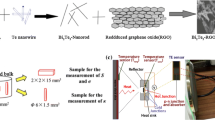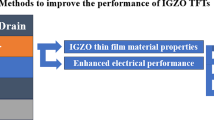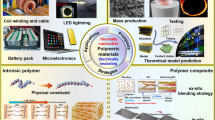Abstract
Highly stable bilayer thin film resistors, which consist of an underlying layer of tantalum nitride and of a capping layer of ruthenium oxide, were developed by taking advantage of the desired characteristics of two different materials in a single system. The resistors fabricated in such a way were highly stable under power loading or thermal cycling. Resistors with one digit temperature coefficient of resistance (TCR) could be easily controlled by the layer thickness ratio of the tantalum nitride to the ruthenium oxide and the ex situ annealing temperature or duration. Auger electron spectroscopy depth profile on the thin films indicates that the ruthenium oxide layer is well defined for the as-deposited form. Nevertheless, interdiffusion takes place after thermal treatment of the bilayer which is used to tune the temperature coefficient of resistance and to stabilize the resistance of the resistors.
Similar content being viewed by others
References
G.E. Pike and C.H. Seager, J. Appl. Phys. 48, 5152 (1977).
T. M. Chen, S.F. Su, and D. Smith, Solid State Electron. 25, 821 (1982).
E. Gofuku, T. Ogama, and H. Takasago, J. Appl. Phys. 66, 6126 (1989).
J. Zelenka, V. Chudoba, J. Rehak, and K. Rohacek, Thin Solid Films 200, 239 (1991).
W. Gawalek, Thin Solid Films 116, 205 (1984).
C.L. Au, W. A. Anderson, D.A. Schmitz, J. C. Flassayer, and F.M. Collins, J. Mater. Res. 5, 1224 (1990).
G.P. Ferraris, Thin Solid Films 38, 21 (1976).
W. J. Ostrander, J. Verhoef, and L. W. Bos, IEEE Trans. Parts, Hybrids, Packag. 9, 155 (1973).
E. Kolawa, F.C.T. So, E.T.S. Pan, and M.A. Nicolet, Appl. Phys. Lett. 50, 854 (1987).
L. Krusin-Elbaum, M. Wittmer, and D. S. Yee, Appl. Phys. Lett. 50, 1879 (1987).
M. L. Green, M. E. Gross, L. E. Papa, K.J. Schones, and D. Brasen, J. Electrochem. Soc. 132, 2677 (1985).
R.G. Vadimsky, R.P. Frankenthal, and D.E. Thompson, J. Electrochem. Soc. 126, 2017 (1979).
S. Saito and K. Kuramasu, Jpn. J. Appl. Phys. 31, 135 (1992).
Q. X. Jia, Z. Q. Shi, K. L. Jiao, W. A. Anderson, and F. M. Collins, Thin Solid Films 196, 29 (1991).
Q.X. Jia, K.L. Jiao, W.A. Anderson, and F.M. Collins, Mater. Sci. Eng. B18, 220 (1993).
Q.X. Jia, K.L. Jiao, W.A. Anderson, and F.M. Collins, Mater. Sci. Eng. B20, 301 (1993).
Author information
Authors and Affiliations
Rights and permissions
About this article
Cite this article
Jia, Q.X., Lee, H.J., Ma, E. et al. Stable thin film resistors using double layer structure. Journal of Materials Research 10, 1523–1528 (1995). https://doi.org/10.1557/JMR.1995.1523
Received:
Accepted:
Published:
Issue Date:
DOI: https://doi.org/10.1557/JMR.1995.1523




